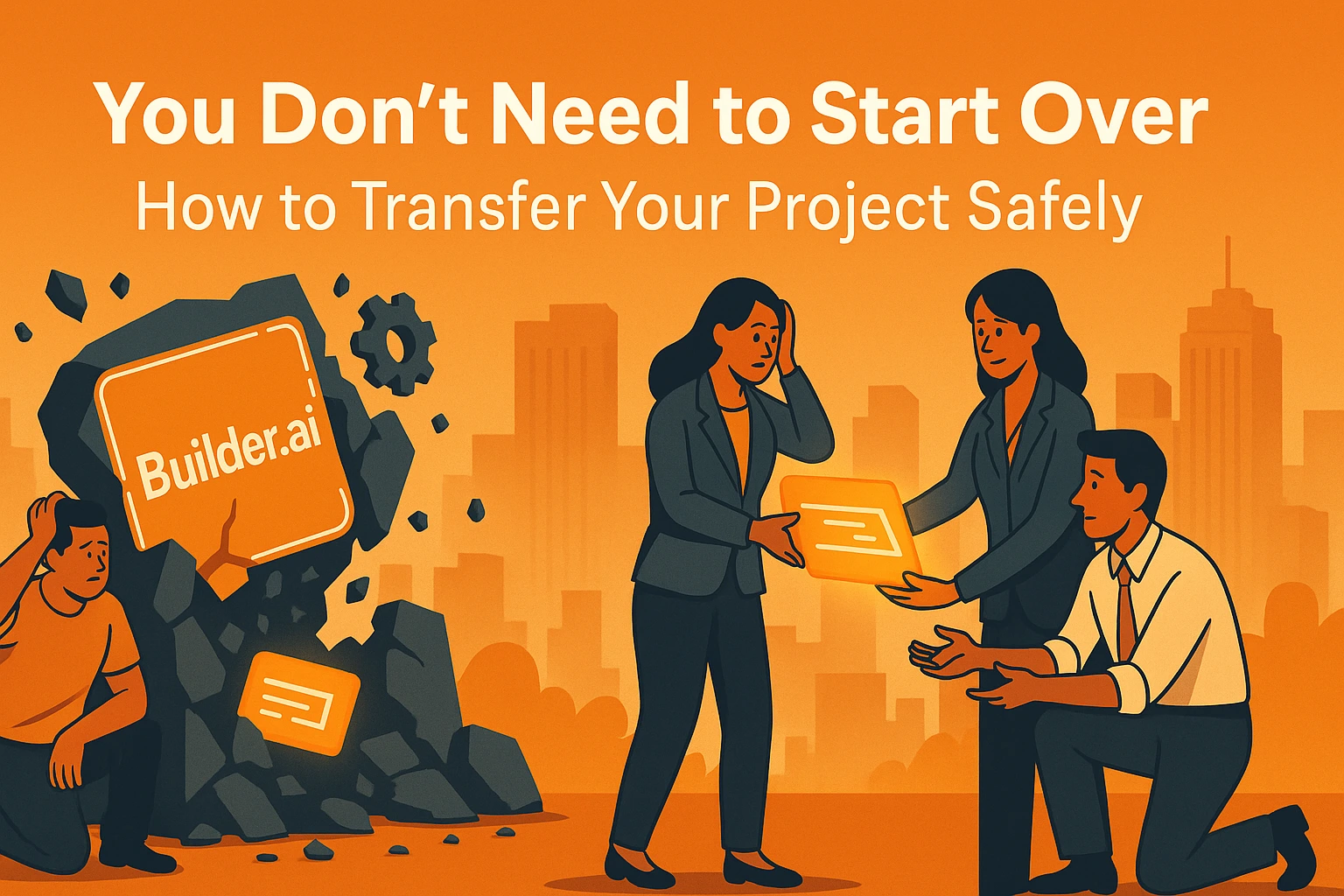“We lost our vendor. We thought we lost everything.”
One of the first calls we get is from clients impacted by the collapse of Builder.ai, worried they’ll have to start over. The truth? In most cases, you don’t.
Builder.ai, once backed by Microsoft and with $250M in funding, has filed for bankruptcy and insolvency. As reported by Bloomberg, a lender seized $37M, leaving only $5M in restricted funds and halting operations in five countries.
In this guide, we’ll walk you through how to transfer your project instead of rebuilding it, what assets matter, and how to make the most of what’s already been built.
What Founders Get Wrong After a Platform Shutdown
In the heat of the moment, many teams:
- Abandon all previous code.
- Hire brand new UI/UX teams.
- Redesign systems from zero.
- Spend months “starting fresh”.
But what they often don’t realise is:
- Parts of the backend are reusable.
- UI can be re-imported.
- Logic flows already exist.
- 60–70% of the thinking is done.
What you need isn’t a reset, it’s a strategic transfer.
Step 1: Audit the Assets You Already Own
Start with this checklist:
- Design files (Figma, Adobe XD, etc.).
- Any email or Slack code snapshots.
- Old APK/IPA files (for reverse-engineering).
- API logic or documented workflows.
- Developer communications (even WhatsApp).
A good dev partner can rebuild from fragments, especially if they understand architecture.
Step 2: Separate What’s Broken from What’s Valuable
You don’t need to duplicate bad architecture, you just need to:
- Retain what makes your app work.
- Fix what makes your app fragile.
This might include:
- Rebuilding integrations.
- Rewriting backend logic.
- Recreating security layers.
But it won’t mean starting your whole product journey again.
Step 3: Use Devs Who Think Like Engineers, Not Rescue Teams
The problem with “rescue-mode” agencies is that they often treat migration like triage.
What you need are builders with context, developers who:
- Understand your users.
- Speak business, not just code.
- Know how to blend logic with legacy.
That’s what HireDeveloper.Dev specialises in technical onboarding that balances speed with structure.
Step 4: Build Forward, Not Backwards
Once your app is functional again, resist the urge to “replicate” Builder.ai features you didn’t love in the first place.
Instead:
- Simplify where possible.
- Document better.
- Build open, not locked-in.
- Plan for scalability.
This is your restart moment. Use it to course-correct, not clone.
Step 5: Retain Your Code and Team This Time
Your new setup must let you:
- Keep your source code.
- Own your Git and infrastructure.
- Add or remove devs at will.
- Scale without re-negotiation.
HireDeveloper.Dev provides a developer-embedded model, so you don’t just get engineers. You get control.
Don’t Start Over, Let’s Save Your Project Now!
If you’re using Builder.ai and worried about your project’s future, you’re not alone. With Builder.ai recently filing for bankruptcy, many businesses are seeking reliable solutions to migrate and protect their digital products.
At HireDeveloper.Dev a trusted and prominent UK-based firm with headquarters in India, we’ve successfully helped clients transition their apps and projects without starting from scratch.
Preserve your code, time, and investment. Schedule your free consultation today, call +9181030 94848.
Related Resources:
- What Happened to Builder.ai? A Breakdown for Startup Founders
- How Builder.AI’s Collapse Shook the Startup World?
- How to React When Your Development Partner Fails Overnight?
- The 5 Stages of Vendor Grief and How to Get Unstuck
- Builder.ai’s Fall: Lessons for Product Owners and CTOs
- Builder.ai Migration Checklist: Save Your Code, Your Time, Your Product
- From Panic to Progress, Real Strategies to Move on from Builder.ai
- Why Moving Fast Now After Builder.ai’s Collapse Will Save You Months Later
- How HireDeveloper.Dev Helps Builder.ai Clients Rebuild with Confidence
- Builder.ai vs. Human-Led Dev Teams: What We’ve Learned
- No More Black Boxes: The Power of Developer Transparency
- AI Was the Hype: Human Execution Is the Reality
- In Crisis, Founders Need More Than Just Tech: They Need Trust
- Why Owning Your Codebase Is Non-Negotiable in 2025
- Avoiding the Next Builder.ai: Red Flags Every Buyer Should Watch For
- From Locked to Liberated: How We Helped Former Builder.ai Clients Reclaim Control
- The Myth of One-Click Apps: Why Custom Always Wins in the Long Run
- What Every Investor Wants to Know: Technical Due Diligence After Builder.ai
- From Recovery to Resilience: A Blueprint for Building Post-Builder.ai

